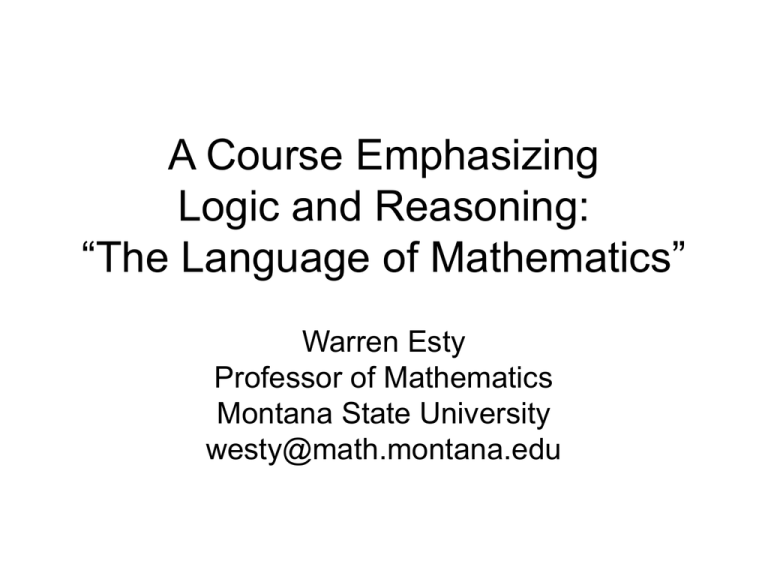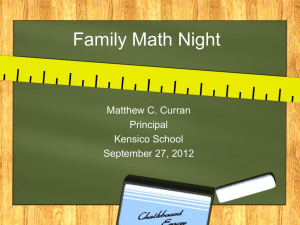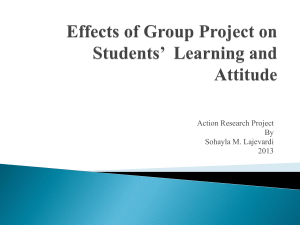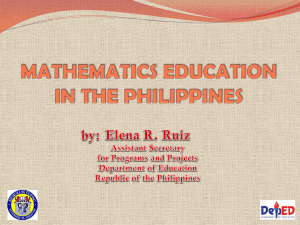A Course Emphasizing Logic and Reasoning: “The Language of
advertisement

A Course Emphasizing
Logic and Reasoning:
“The Language of Mathematics”
Warren Esty
Professor of Mathematics
Montana State University
westy@math.montana.edu
The world is changing rapidly.
Is teaching keeping up?
What do we teach?
Information
Skills
Impart information,
computational skills
• Information is cheap
•
Facts are on the web
• Computational skills are cheap
•
If anyone can compute it, calculators
and computers can do it accurately and
faster
• “Expert systems” are replacing people
Theorem: The value of traditional
mathematical skills has gone way
down.
Corollary: We should refocus our
teaching toward skills that add value.
What adds value?
• Knowing how to use calculators and computers
• Knowing when to use various math algorithms
• Experience with problems
• Also, of course, many traditional activities
(especially developing concepts)
Add value by
• Preparing for lifelong learning
Learn to read!
• Learning to make (the right) things
“come to mind”
• Learning to reason logically
The problem with searches
• “I can just look it up.”
• However, “it” must come to mind
• And you must be able grasp it when you
find it
We found that kids hit a wall,
and that wall is called fourth
grade. At that moment, a kid
shifts from learning to read to
having to read in order to learn.
-- David Britt, Children’s Television
Workshop President, in 1992
Half of all kids
never make that transition.
-- Colette Daiute, Harvard Professor
of Human Development, in 1992
Imagine how much worse
the statistics would be
if they were about
the fraction of kids who
can read mathematics
to learn mathematics.
Why is reading important?
Do you really think
students can read math?
• Why should they be able to?
• Who ever taught them to?
• Who ever required them to?
Math is difficult to read
• It is concise and precise
in a non-concise and non-precise age
• [0, 1]
• (0, 1)
• {0, 1}
are different in important ways
that are alien to our students
43 College calc profs
asked their students
• 8% read most of the chapters
• 17% read sections they didn't understand from
lectures
• 69% typically started by working homework
and turned to examples if they had trouble
• 3% said they never opened the book.
Is Math a Language?
•
•
•
•
•
Communication
By symbols
Non-instinctive
Conventional, learned meanings
Shared by a community
Algebraic Language has
• Vocabulary
•
•
•
•
•
•
•
•
nouns, pronouns, verbs,
“expression”, “factor”, …
Grammar
Syntax
2x2 is not (2x)2
Pronunciation {x | x2 > 25}
Synonyms If x > 5, then x2 > 25,
For all x > 5, x2 > 25.
Negations
negate: “If x2 > 25, then x > 5.”
Conventions 3x2
Abbreviations
Sentence and paragraph structure
Placeholders
• 3(x + 4) = 18
• 3(x + 4) = 3x + 12
• 3(c + 4) = 3c + 12
• Let f(x) = x2. “f” is not a number, “f(x)” is.
• Find f(x+h) =
How do you add fractions?
• Explain this in English
Explain this in Mathematics
How do you solve these?
• x + 4 = 13 or
• x2 + 12 = 100
• x/3 + 7 = 42
Generally, for the first step:
• x + a = b iff x = b - a
Pattern recognition
•
x+a=b
iff
problem-pattern
x=b–a
solution-pattern
How do you factor this?
• x2 + bx + c
x2 + 10x + 16
• x2 + bx + c = (x + d)(x + k)
iff b = d+k and c = dk.
• The left-side pattern factors
into the right-side pattern
under certain conditions.
What is the best way
to learn a language?
Spanish?
German?
• Start very young
• Interact with others who use it
Our children can’t “Start young”
• Many elementary-school teachers don’t
know the language
• And avoid it
• And the curriculum lets them
• We often start the language in 8th or 9th
grade (late!)
Few El-Ed students
choose extra math
• They don’t have time in their curriculum
• They are not expected to be responsible
for algebra
• A math-as-a-language course is not
traditional
• Few colleges have one
Linguists assert: It is difficult to
have and retain thoughts without
the proper language in which to
categorize and express them.
• Musical notation
• Symbolic mathematics
Learn to read
• Theorem: 1+2+3+…+n = n(n+1)/2.
• Find 1+2+3+4+…+70
• Find 1+2+3+…+n+…+(n+5)
The Quadratic Theorem
• If ax2 + bx + c = 0 and a is not 0,
• Then x = …
•
•
•
•
Find x when
Find y when
Find b when
Find x when
2x2 – kx = 12
x2 + 3x + 5y2 – 12y = 100
c2 = a2 + b2 – 2ab cos(C)
sin x + (sin x)2 = 0.82
The Language of Mathematics
• 1. Algebra as a language
Abstraction, Patterns, Order, Reading, Arithmetic
methods expressed
• 2. Sets, functions, algebra
Notation, Methods expressed
• 3. Logic for Mathematics (logical equivalences)
• 4. Sentences,Variables, Generalizations,
Existence Statements, Negations
• 5. Proofs (paragraphs in the language)
New courses
• Who will go to bat for one?
• It is not a traditional course
• Previous teachers, administrators, parents, didn’t take
this course (It didn’t exist)
• Math profs usually don’t care much about elementary ed,
or have much influence over it
• Not everyone realizes the language aspects of
mathematical symbolism – shouldn’t students just get
that by osmosis in their math classes?
• Colleges readily accept new courses if students will take
them, but
• Who will take it, if it is not required?
The world has changed.
Conclusion
• Information is incredibly cheap
• Calculations are incredibly cheap
• Theorem: Much of the math we have
been teaching is not worth much.
• Learning to read is not easy
• Learning to read is worth a lot
• We must enable our teachers to help
students learn to read Mathematics.
References
• http://augustusmath.hypermart.net/
• “Language Concepts of Mathematics,” by Warren Esty,
Focus on Learning Problems in Mathematics, 1992,
Volume 14, number 4, pages 31-54
• “A General Education Course emphasizing Mathematical
Language and Reasoning,” by Warren Esty and Anne
Teppo, Focus on Learning Problems in Mathematics,
1994, Volume 16, number 1, pages 13-35.
• “The Assessment of Mathematical Logic: Abstract
Patterns and Familiar Contexts” (joint with Anne Teppo
and Kay Kirkpatrick), Psychology of Mathematics
Education (Proceedings of the 27th Conference of the
International Group for the Psychology of Mathematics
Education), 2003, 283-290.
Users
• Profs. Robert Fisher and Cathy Kriloff,
Idaho State University. fishrobe@isu.edu
krilcath@isu.edu
• Prof. Genevieve Knight, Coppin State
University, Baltimore. gknight@coppin.edu
• Prof. Mircea Martin, Baker University,
Baldwin City, Kansas.
Mircea.Martin@bakeru.edu







